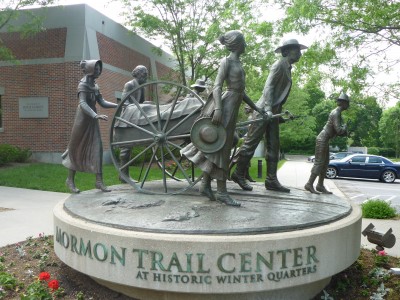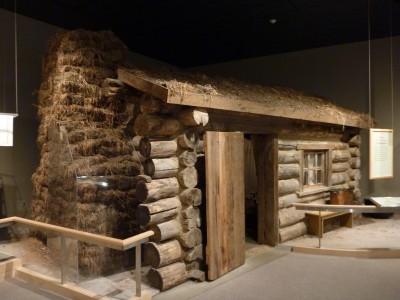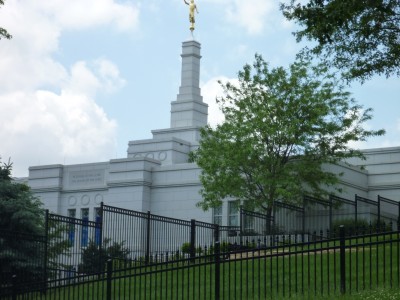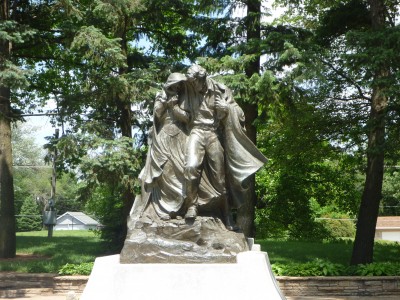After the Saints built up a thriving community in Nauvoo, Illinois, they were surrounded by angry mobs wishing to drive them out. The Martyrdom of the Prophet Joseph Smith and his brother Hyrum Smith, though not unexpected, was a turning point for the Saints, and they knew they would have to leave Illinois. Church leaders had already been discussing moving west to the area of the Rocky Mountains and had been talking to explorers and studying what maps were available at the time.
 As persecution increased, the Saints realized they would have to leave Nauvoo even earlier than originally planned. Instead of leaving in April of 1846, an emergency meeting was held by Church leaders and they decided to leave immediately. The exodus of the Saints west began on February 4, 1846. Those who left early had been able to make the most preparations for their journey, though most things were still unknown. Though safety from persecution was the deciding factor in such a quick evacuation, the desire to go ahead and prepare for the rest of the Saints who would follow was also a factor for the first group to leave.
As persecution increased, the Saints realized they would have to leave Nauvoo even earlier than originally planned. Instead of leaving in April of 1846, an emergency meeting was held by Church leaders and they decided to leave immediately. The exodus of the Saints west began on February 4, 1846. Those who left early had been able to make the most preparations for their journey, though most things were still unknown. Though safety from persecution was the deciding factor in such a quick evacuation, the desire to go ahead and prepare for the rest of the Saints who would follow was also a factor for the first group to leave.
It was the middle of winter and very cold. One of the first boats to carry people over the Mississippi river was sunk when an ox kicked a hole in it. Two weeks after the first Saints crossed, a miracle occurred. The Mississippi river froze over solid, allowing the Saints to cross with their wagons without the peril of boats. The cold snap brought the blessing of the frozen river, but it was also very hard on the Saints, most of whom were not prepared for the harsh conditions, which awaited them in the Sugar Creek encampment where those who had crossed the river gathered before continuing on their journey.
 While early estimates placed the length of the journey to the Rocky Mountains at about 4–6 months, Iowa endured a very wet spring. In some places the mud came up to the wagon beds making progress nearly impossible. It took the Saints 131 days (just over four months) just to get across Iowa. They were forced to stay in the settlements of western Iowa for the winter of 1846–47 before they could make it to the Rocky Mountains. The settlement where they endured this winter was called Winter Quarters, located on the west side of the Missouri River in Nebraska. Nearly 3,500 Saints gathered at this settlement during that winter, surviving in crowded, makeshift shelters which were no match for the bitter cold and which housed 10–15 people each. Malaria ravaged the people in the summer and when winter came it brought cholera, scurvy, night blindness, and severe diarrhea.
While early estimates placed the length of the journey to the Rocky Mountains at about 4–6 months, Iowa endured a very wet spring. In some places the mud came up to the wagon beds making progress nearly impossible. It took the Saints 131 days (just over four months) just to get across Iowa. They were forced to stay in the settlements of western Iowa for the winter of 1846–47 before they could make it to the Rocky Mountains. The settlement where they endured this winter was called Winter Quarters, located on the west side of the Missouri River in Nebraska. Nearly 3,500 Saints gathered at this settlement during that winter, surviving in crowded, makeshift shelters which were no match for the bitter cold and which housed 10–15 people each. Malaria ravaged the people in the summer and when winter came it brought cholera, scurvy, night blindness, and severe diarrhea.
 During the first winter here, one in twelve died for a total of 369 burials. About 37 percent of the population was sick at the same time and nearly half of the deaths were children under the age of 3. It was truly a time of testing and trial for the Saints who had to endure it. Still, work went on. The men planted crops for those coming after their group would have passed on. The women continued their daily chores and the people held activities such as dances, theological discussions, parties, and of course Church meetings. Faith grew and the Saints grew closer together.
During the first winter here, one in twelve died for a total of 369 burials. About 37 percent of the population was sick at the same time and nearly half of the deaths were children under the age of 3. It was truly a time of testing and trial for the Saints who had to endure it. Still, work went on. The men planted crops for those coming after their group would have passed on. The women continued their daily chores and the people held activities such as dances, theological discussions, parties, and of course Church meetings. Faith grew and the Saints grew closer together.
On May 12, 1846, the U.S. Congress declared war on Mexico. Secretary of War William Marcy authorized Colonel Stephen W. Kearny to recruit and enlist Mormon men to go fight in California, and in June 1846, Captain James Allen travelled to the Mormon encampments in southern Iowa to recruit 500 men. Wilford Woodruff said, “I had some reasons to believe them to be spies and that the President had no hand in it. We however treated them with civility and directed them on to Council Bluffs to lay the case before the President.”
It is little wonder that the Saints were dubious at this request of a government which had repeatedly refused to help them in their intense persecutions. However, Brigham Young, Heber C. Kimball, and Willard Richards “decided it was best to meet Captain Allen in the morning and raise the men wanted.” These men recognized the opportunity of enlistment for men to earn money which they sorely needed to move the Saints West. In addressing the Saints regarding the issue, Brigham Young said, “Let the Mormons be the first men to se their feet on the soil of California. . . . This is the first offer we have ever had from the government to benefit us.” Over several days, the 500 men were raised. Called the Mormon Battalion, these men fulfilled their duties but were blessed to never have to fight in the war with Mexico. They did receive the capital that the Church needed, and all the families they left behind were miraculously provided for and looked after. It was only after the Mormon Battalion left that Winter Quarters was fully developed.
Eventually the settlement at Winter Quarters was abandoned and the Saints finished their outfitting in Kanesville, Iowa, across the Missouri River. Thousands of pioneers benefited from this experience of the first group of Saints. All those who travelled west to settle were able to learn from the Saints’ experiences and knowledge. Of course, it was especially beneficial to the other Mormon settlers who came after them, but the United States owes much of its settlement in the west after this period to the sacrifices of this first group of Mormon settlers.
In 1847, a smaller group left Winter Quarters for the Rockies. It took 111 days for them to reach the Salt Lake Valley. Immediately men began planting and building. Almost as soon after arriving, Brigham Young and a small group turned around to head back to Winter Quarters and send the rest of the Saints on their way. Four days after arriving in the Salt Lake Valley, Brigham Young chose a temple site.
Over the years, 100,000 Mormons travelled to Salt Lake City; 85,000 of them came from outside of the United States. As the railroads expanded and the Transcontinental Railroad was eventually finished, the journey was cut from 3 months to  3 days. Saints continued to pour into the Salt Lake Valley and to spread out in their developments. Winter Quarters, which was called the “Valley Forge of Mormondom” by John Young, Brigham’s son, was an area which required great sacrifices from those who lived there. These sacrifices led to great blessings for those who endured, and they in turn were able to bless all those who came after them.
3 days. Saints continued to pour into the Salt Lake Valley and to spread out in their developments. Winter Quarters, which was called the “Valley Forge of Mormondom” by John Young, Brigham’s son, was an area which required great sacrifices from those who lived there. These sacrifices led to great blessings for those who endured, and they in turn were able to bless all those who came after them.
Today a temple stands next to the cemetery at Winter Quarters as a reminder of all the blessings and freedoms for which those who died here were fighting.
(Quotes taken from Church History in the Fulness of Times Student Manual.)
Twitter •


 Watch a video about the restoration of the gospel on lds.org
Watch a video about the restoration of the gospel on lds.org